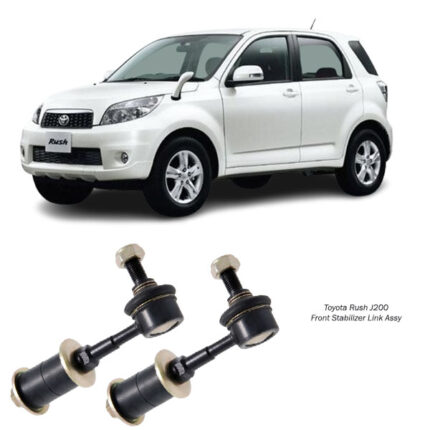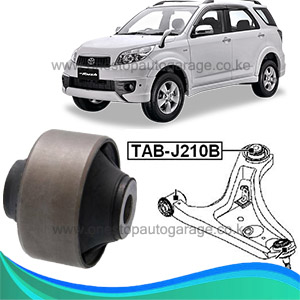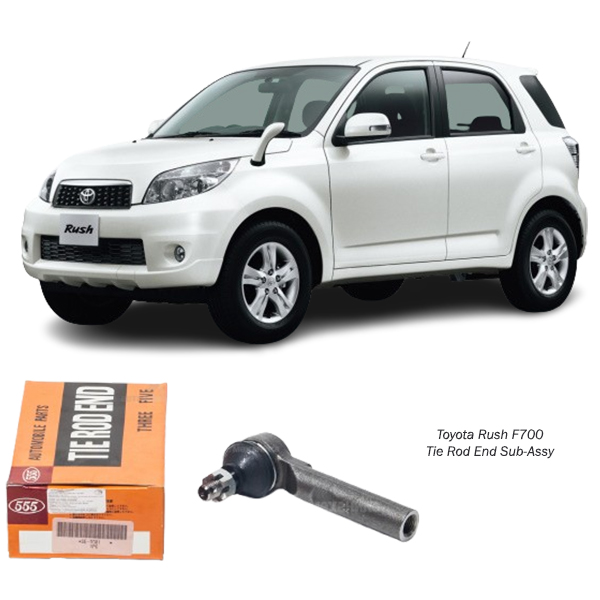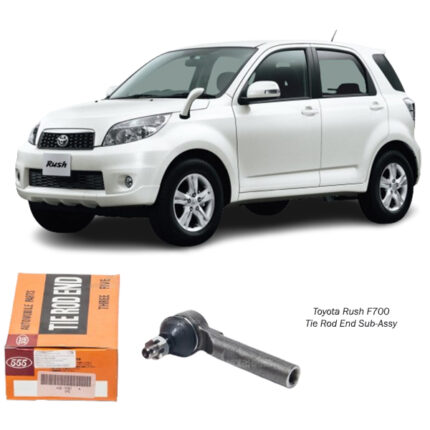-10%
Get Toyota Rush F700 Tie Rod End Sub-Assy SE-T081 in Kenya
The tie rod end sub-assembly is a crucial component of a vehicle’s steering system. It connects the steering rack or steering gear to the steering knuckle, facilitating the transfer of steering input from the driver to the wheels. As an essential part of the steering linkage, the tie rod end sub-assembly ensures that the vehicle’s wheels respond accurately to steering movements, thereby affecting vehicle handling, safety, and overall driving performance. This detailed explanation will explore the role, design, components, functions, types, signs of wear, and maintenance of tie rod end sub-assemblies.
1. Overview of the Steering System
Before delving into the specifics of the tie rod end sub-assembly, it’s essential to understand its role within the vehicle’s steering system. The steering system’s primary function is to allow the driver to control the direction of the vehicle by turning the front wheels. The system converts the rotational movement of the steering wheel into lateral movement of the wheels.
The steering system includes several components, such as the steering wheel, steering column, steering rack or gear, tie rods, and tie rod ends. The tie rod ends are integral to the steering linkage because they link the steering rack to the wheels, ensuring that steering movements are accurately reflected in the wheel’s position.
2. Components of the Tie Rod End Sub-Assembly
A tie rod end sub-assembly consists of multiple parts that work together to achieve proper steering control. The key components of the tie rod end sub-assembly include:
a. Tie Rod
The tie rod is a long, slender component that connects the steering rack or steering gear to the steering knuckle, transmitting the force from the rack or gear to the wheels. The tie rod is typically made of high-strength steel to withstand the forces exerted during steering.
b. Tie Rod End (Ball Joint)
The tie rod end is the ball-joint-like component that connects the tie rod to the steering knuckle. The ball joint allows for angular movement, which ensures that the wheel can turn left or right in response to steering input. The tie rod end is typically made from durable materials like forged steel or high-strength alloys for maximum durability.
c. Dust Boot or Cover
A dust boot is a flexible rubber or synthetic cover that surrounds the tie rod end and helps protect it from dirt, moisture, and debris. This component is essential for ensuring the longevity of the tie rod end, as it keeps contaminants from entering the joint, reducing the risk of premature wear or failure.
d. Inner and Outer Tie Rod Ends
In many vehicles, the tie rod sub-assembly consists of both inner and outer tie rod ends. The inner tie rod end connects to the steering rack or steering gear, while the outer tie rod end connects to the steering knuckle. These components are typically designed with a threaded end, allowing for precise adjustments during alignment and repairs.
e. Lock Nut
A lock nut is used to secure the position of the tie rod end after it has been adjusted. It prevents the tie rod end from loosening during operation, ensuring that the steering linkage remains intact and precise.
3. Functions of the Tie Rod End Sub-Assembly
The tie rod end sub-assembly serves several important functions in a vehicle’s steering system. The most notable functions include:
a. Transmitting Steering Input
When the driver turns the steering wheel, the steering column transmits the rotational movement to the steering rack or steering gear. The tie rods and their ends convert this rotational motion into linear movement that turns the wheels in the desired direction. The tie rod end sub-assembly ensures that the force generated by the steering wheel is accurately transferred to the wheels, allowing for precise control.
b. Allowing for Wheel Movement
The tie rod end provides the necessary angular movement between the tie rod and the steering knuckle. This movement enables the wheels to pivot left or right as required when turning the steering wheel. The ball joint in the tie rod end is essential for facilitating this angular motion without binding or restriction.
c. Ensuring Proper Alignment
The tie rod end sub-assembly also plays a role in maintaining the vehicle’s wheel alignment. Proper alignment ensures that the wheels are positioned correctly in relation to the vehicle’s body, allowing for optimal handling, even tire wear, and stable driving behavior. Misalignment due to faulty or worn tie rod ends can lead to poor handling, uneven tire wear, and potential safety hazards.
d. Reducing Steering Play
In a well-functioning steering system, the tie rod end sub-assembly helps minimize steering play— the small amount of free movement in the steering wheel before the wheels begin to turn. Steering play can result from worn or damaged tie rod ends, leading to imprecise handling. Properly maintained tie rod ends eliminate this slack, ensuring that the vehicle responds quickly and precisely to steering input.
4. Types of Tie Rod Ends
There are different types of tie rod ends designed for specific vehicle applications, and these may vary based on the steering configuration or type of suspension used in the vehicle. The most common types include:
a. Conventional Tie Rod Ends
Conventional tie rod ends are used in traditional steering systems where the tie rod end is connected to a steering arm via a ball-and-socket joint. These are most commonly found in vehicles with rack-and-pinion steering, which is prevalent in most modern cars and trucks.
b. Inner and Outer Tie Rod Ends
In vehicles with more complex steering systems, such as those using a recirculating ball steering gear, the tie rod end sub-assembly may include separate inner and outer tie rod ends. The inner tie rod connects to the steering rack, while the outer tie rod connects to the steering knuckle.
c. Offset Tie Rod Ends
Offset tie rod ends are often used in vehicles that require more precise alignment or steering adjustments, such as racing cars or modified vehicles. The offset design allows for greater control over steering geometry and adjustments, improving handling during high-performance driving.
5. Signs of Worn or Damaged Tie Rod Ends
Over time, tie rod ends can experience wear due to constant movement, friction, and exposure to the elements. Identifying signs of a faulty or worn tie rod end is crucial for preventing potential steering failures. Common symptoms of worn or damaged tie rod ends include:
a. Uneven or Premature Tire Wear
Worn tie rod ends can lead to misalignment of the wheels, which can result in uneven tire wear. If the vehicle experiences unusual tire wear patterns—such as more wear on the inside or outside edges of the tire—it may indicate that the tie rod ends need to be replaced.
b. Steering Wheel Vibration
A damaged or worn tie rod end can cause the steering wheel to vibrate, especially at higher speeds. The vibration may occur because the tie rod end is no longer able to maintain the correct alignment of the wheels, causing instability in the steering system.
c. Excessive Steering Play
As tie rod ends wear out, they may become loose, leading to increased steering play. This manifests as a delay in response when turning the steering wheel. Excessive steering play can be dangerous, as it reduces the accuracy and responsiveness of the vehicle’s steering.
d. Clunking or Popping Noises
If you hear clunking, popping, or knocking sounds from the front of the vehicle while turning, it could indicate that the tie rod ends are worn or damaged. These sounds occur when the ball joints within the tie rod ends become loose, leading to metal-to-metal contact.
e. Misalignment or Pulling
If the vehicle pulls to one side or the steering wheel is off-center, it may be a sign of a faulty tie rod end. Worn tie rod ends can disrupt the alignment of the wheels, leading to poor handling and uneven road tracking.
6. Maintenance and Replacement of Tie Rod Ends
Regular maintenance and inspection of the tie rod end sub-assembly are critical for ensuring the safe and effective operation of a vehicle’s steering system. Here are some key maintenance practices:
- Regular Inspections: Have the tie rod ends inspected regularly, especially during routine wheel alignments or tire rotations. Early detection of wear can prevent costly repairs and enhance safety.
- Replace Worn Components: If a tie rod end shows signs of damage, it should be replaced immediately. Driving with worn tie rod ends can cause further damage to the steering system and compromise safety.
- Lubrication: Some tie rod ends feature grease fittings that allow for regular lubrication to reduce friction and extend the life of the component. Ensure these fittings are lubricated as per the manufacturer’s recommendations.
- Alignment Checks: After replacing the tie rod ends, perform a wheel alignment to ensure the vehicle’s wheels are correctly aligned, reducing tire wear and improving handling.
Conclusion
The tie rod end sub-assembly is an essential component in a vehicle’s steering system, responsible for transmitting steering input from the steering rack to the wheels and ensuring proper wheel alignment and movement. With its durable construction and ball joint mechanism, it plays a key role in providing precise, responsive steering. Regular inspection and maintenance of tie rod ends are crucial for preventing steering problems, maintaining vehicle safety, and ensuring optimal handling performance.
Follow us on Facebook for more parts.




